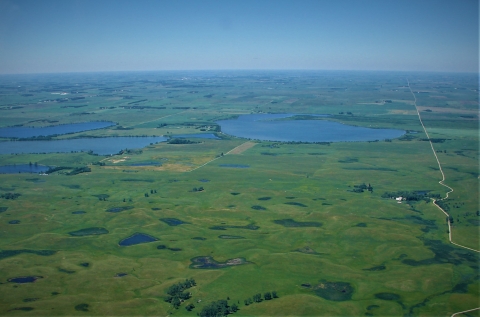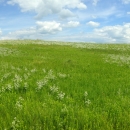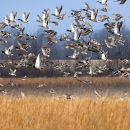Visit Us
We welcome you to visit the waterfowl production areas that are part of Madison Wetland Management District. These areas are open to hunting, trapping, wildlife watching, and photography.
In addition, our visitor center is open Monday - Friday, 8:00 am - 4:30 pm, except Federal Holidays. The headquarters and visitor center is located 2 miles east of the town of Madison, South Dakota and 3/4 miles south of the junction of Highway 34 and Highway 19. Inside the visitor center you can view framed prints donated by nine local South Dakota artists, and observe the fur, skull, track, and scat displays. You can also look for birds using a spotting scope set up on the observation deck.
Location and Contact Information
About Us
Wetland management districts are little known but important components of the National Wildlife Refuge System. Within each District, small parcels of land called waterfowl production areas are purchased and managed by the U.S. Fish and Wildlife Service to provide nesting habitat for waterfowl (ducks, geese, and swans). Waterfowl production areas are concentrated where the ducks are - in the Prairie Pothole Region of the northern Great Plains. Today, there are about 34,000 tracts protected as waterfowl production areas in the country.
McCarlson Waterfowl Production Areas, located in Day County, was the first waterfowl production area waterfowl production area
Waterfowl production areas are small natural wetlands and grasslands within the National Wildlife Refuge System that provide breeding, resting and nesting habitat for millions of waterfowl, shorebirds, grassland birds and other wildlife. Virtually all waterfowl production areas are in the Prairie Pothole Region states of Iowa, Minnesota, Montana, North Dakota and South Dakota.
Learn more about waterfowl production area . It was purchased in 1959. Since then, over 38,000 acres have been purchased in the Madison Wetland Management District for ducks and other wildlife. Funds to purchase waterfowl production areas, come from the sale of Migratory Bird Hunting and Conservation Stamps, also known as Duck Stamps. Hunters over the age of 16 are required to purchase a stamp prior to hunting waterfowl. Nationwide, nearly 5 million acres of habitat have been protected with funds from Duck Stamp sales. These areas are open to hunting as well as other wildlife activities like birdwatching, trapping, and photography.
In South Dakota, half of our wetlands and about 35% of grasslands have been lost to development and agriculture, and this loss continues. In the past decade, more than 15,000 wetland acres per year have been drained in the state. In addition, over 1 million acres of grass were plowed up in the western corn belt from 2006-2011. In South Dakota alone, 27,000 acres of native prairie were converted to cropland in 2011-2012.
Conservation easements are another way to protect these vital habitats. The District includes wetland and grassland habitats protected through various private land easement programs. These easements are an effective way to preserve these vital habitats for wildlife and future generations of landowners, hunters, birdwatchers, anglers, and anyone that relies on our natural resources for the beauty, recreation, and ecosystem services they provide.







